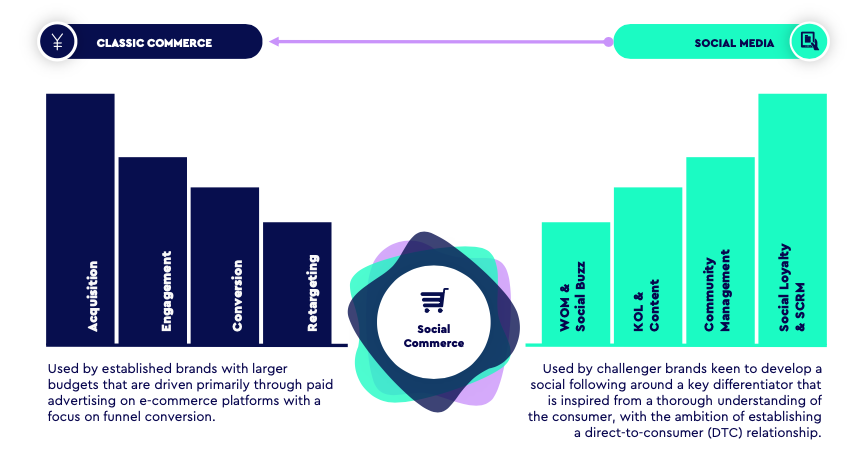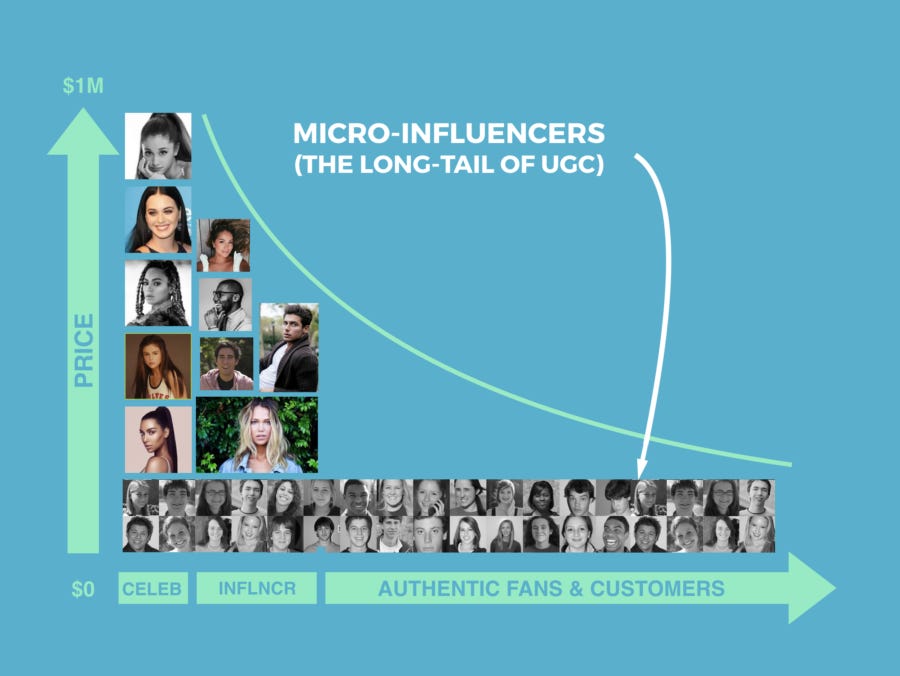In an increasingly social world, influence marketing is becoming an industry game-changer, particularly in the beauty and fashion sectors. Successful influencers have what brands crave: A passionate fan-base. With that, they've unknowingly become hugely important gatekeepers for up and coming brands. As a brand, if you can convince these influencers - you might actually have a shot at taking your industry by storm. And while some savvy players have it covered, many are still missing on that crucial connection, ultimately putting their business at risk.
Fashion and Beauty legacy is under attack – But why?
Suppose we say that social networks and influencers have disrupted many industries, particularly beauty and fashion, it would be an understatement. But in this increasingly crowded space, some players stand out. What's their secret weapon, you must be wondering? They have applied a framework that perfectly addresses the pyramid of influencers, particularly the bottom of the pyramid, the micro-influencers, where the real magic happens. Indeed, that’s something business analysts need to pay attention to as microeconomics has a higher ROI and engagement; thus, scaling influencer marketing ultimately means leveraging a framework with a quantity of middle and micro-influencers in an always-on mode rather than activating a couple of macro-influencers here and there.
That’s precisely how savvy DTC operates, allowing them to eat marketing shares of traditional legacy brands who just don’t know how to apply the influencer marketing playbook at scale. Most of them are trying to get back in the game by spending billions to buy these companies: L'Oréal acquired NYX Cosmetics. Estée Lauder did the same with Too Faced, and Coty bought a majority stake in Kylie Cosmetics. But is this enough to gain back the control? Probably not. Because legacy brands need to make great structural changes across all operating brands and all geographies if they want to get back in the game.
DTC Influencer driven empires – The industry’s new black
If you think you know everything about influencer marketing, think twice. Anyone can carry out an influence campaign, but very few know how to deploy this at scale strategically. Some DTC brands have understood the crucial nuance and set up influencer marketing as their major acquisition channel and earned media value as the essential driving KPI of their business.
The Hut Group (THG) is a British holding that includes 20+ DTC and retail brands in the beauty, fashion and supplement segments. Their $2.4B IPO in September 2020 broke records, and as of today, they are worth $6.4B. What did they do differently? THG has built its own influencer platform — THG Ingenuity — which they claim has 10,000 influencers for its own brands and offers its services to top legacy brands as a white label service. In 2019, influencers generated nine percent of all revenue (which translates to approx. 111M€).
SheIn is a $15 billion Chinese fast-fashion retailer brand that has grown >100% y/y for eight consecutive years. The search query "Shein Haul" that shows influencers unpacking their latest SheIn acquisitions is searched up to 50,000 times per month on Google. And that's just the tip of the iceberg because it doesn't account for all the long tail keyword searches and the direct searches on YouTube. Many of these videos have been viewed hundreds of thousands of times, and some have reached upwards of three million views. We are not done yet, go to YouTube, type the keyword “Shein,” and sort out the videos by date of publication. You’ll notice that every day - yes, every day - there are between five and ten videos published by influencers, whether macro, middle or micro. The same goes for Instagram. That's what we mean by scale.
Boohoo is a UK-based online fashion retailer. They operate on similar principles and have set up many targeted influencer programs to extend their reach. For instance, they have a student ambassador program where they offer students free clothes and event invites in exchange for them wearing the brand at their universities. It helps them infiltrate spaces in a less invasive way.
Ipsy is a US beauty retailer. After growing their subscription base by 60 percent during the pandemic, the US firm bought competitor Boxycharm back in October 2020 to form what could be a billion-dollar beauty subscription service. The brand has a 20,000-square-foot content studio in Los Angeles, allowing them to create 5,000 assets every month. Their studio is designed to facilitate more content-creation opportunities for beauty influencers and brands alike.
With social commerce gaining ground, there is a high probability that these brands will keep on shooting for the stars. The outcomes are phenomenal: Kombo ventures operating DTC brands @insertnamehere, @wakeheart and @glamnetic went from $4M to $75M in just one year. It’s no wonder that Alibaba’s e-commerce platform is looking for +100,000 content creators and influencers globally to build their influencer network – it is all because they know how massively it can impact their name and business.
Sales through influencers – The road to success
The secret sauce of brands who succeed on social networks are the ones implementing top-notch influencer marketing strategies to drive sales. We know about this now.
Micro and nano influencers are driving ROI for brands, as demonstrated below by Rex Woodbury


So how can one set-up influencer marketing at scale? What are the key considerations?
Before you start, keep in mind that scaling influencer marketing doesn’t work for all sectors. It requires working in an environment where influencers are passionate and love to talk through their social networks about topics such as gaming, beauty and fashion.
Choose your social network and focus on it until you find profitability. YouTube is the best for beauty and fashion brands because reviews such as hauls, unboxings, etc. are real demonstrations from influencers. Brands with the right product and influencer marketing strategy find ROI. People spend time watching, and the level of engagement is much higher than on Instagram. They watch a video and get the appropriate links and promo codes below the videos. So, they can click and exit from the platform (which is not the case for Instagram). Hence, YouTube is a high-performing social network for driving traffic and sales to your brand. It requires a clear framework and here are the things you need:
A clear understanding of your economics.
A centralized team.
Unique unboxing experiences.
Tech and data.
Process.
Economics need to be integrated from the start and built on the fact that influencer marketing has a cost like any other acquisition channel. If you want to be serious about it and scale, here are the costs to define your Customer Acquisition Cost (CAC) with influencer marketing:
People (average one person for 500 collabs a year should be a target)
An efficient website, i.e., Shopify de facto (don’t think about any other platform)
The technologies you will need, and an influencer marketing platform that can help you scale, track your posts and sales from every influencer.
Last but not least, finance the cost of goods you will offer and send.
Packaging for your unboxing.
Shipments to influencers.
Cost for sponsored posts.
Promo codes and discounts to customers that the influencer will give to their fans. This will have a strong impact on your pricing.
Build a centralized team. This will scale the operations to deal with influencers (gifting and paid sponsorships). Successful DTC brands have one centralized team addressing all countries. On the other hand, legacy brands have different marketing teams for different countries, and they fail to leverage their influencer marketing (too many tools and different practices).
Design unique unboxing experiences. We highly advise you to look at this YouTube channel from Lumi, a packaging company for DTCs, featuring all the best unboxing experiences.
Choose an influencer marketing platform. It will help you identify, reach out and track the flow of messages and deal with influencers. Grin, an influencer marketing software platform for DTC brands that helps them launch campaigns, track sales and integrate the flow with Shopify stores (check the founder’s vision here) is a good option. If you are operating in beauty and fashion, Tribedynamics and Launchmetrics are platforms you should have a look at.
Process. That’s where you need to be a rock star.
If you really want to get more eyeballs on your brand and better ROI, micro-influencers are the way to go.
To get the best ROI, you need to scale from a few influencers to hundreds, thousands, and then ten thousand influencers.
Identify the right influencers by creating a list of brands your customers love and find influencers featuring them.
Reach out to influencers with a flow of emails.
Try to give products and avoid paying influencers with less than 10k followers. Above 10K followers, you’re dealing with a sponsored post for each influencer, and that’s where your team must have the data and skills to negotiate sponsored opportunities. Here is a good overview of influencer rates in 2021.
We highly advise segmenting the list of influencers and knowing how many views they have after 30 days to understand the click-through rate from these views and your website's conversion rate. This will help you negotiate deals and give you a point to oversee your future revenue.
It is extremely important that you be featured at the beginning of the video if you want to be seen by the influencer’s audience and also make sure the influencer will feature your link before all the others.
Once you reach a few thousand sponsored posts, you will better understand your metrics, such as click-through rates (number of clicks/number of views) and conversion rates from each influencer. Then, nurturing relationships with influencers and working with the best ones will become key. Having tight and regular relationships with influencers is becoming a strong metric for investors.
Final thoughts — on the macro side, creators with influence are building huge empires with deep diversification of products. As an example, nine-year old YouTuber Ryan Kaji has begun generating $30M in merchandising last year. But that’s just one aspect, as the future will involve more innovative business models around micro-transactions and social currencies. In addition, new dedicated fintech tools will help these big influencers run and grow to become the new small businesses of the future. Current examples include Creative Juice to help creators invest in other creators or Karat, the black card for influencers. Thus, collaborating with these macro-influencers will get even harder for brands, emphasizing the need to strengthen their micro-influence strategies. Here, too, you need to watch out for new uses, like social and community-tools that aim to scale and make micro-influencer assets go viral.
Finally, don’t lose sight of the bigger picture underlying all this: Retailtainment. But think big, retailtainment is not just live-streaming, it’s community shopping, conversational shopping, gamified commerce, shoppable streaming, an electrifying drop culture, Xtended reality shopping, and much more. To thrive in this new era, it’s all about experiences and pushing the boundaries of what is conventional and often, to be honest, quite boring. Recently, the Zuzeum Art Centre presented their latest exhibition within the food delivery app Wolt. The lines are blurring and escaping for the better. Adapt or die. It might sound cliché, but believe us, the saying has never been so true.
Marie & Thomas Owadenko
Recently, I recorded two podcasts in english. One here with Newsletter Crew on newsletter monetization. A second one here with Viral We Grow, on trends and curation.
Meditative Design by Krista Kim who recently sold - for over half a million dollars - the world’s first NFT house
A very interesting overview of Psychedelic Wellness.
As someone that both hates Zoom and needs to walk to feel good, I’m excited about this.
Glassmorphism is cool.
Brand Marketing. Weirdly smart.
“Where the best content lives.” I’m intrigued and waiting for more. Thoughts?
Want to pull some good pranks on friends? I would suggest giving a shot at the goats or the boomer songs.






